Best understood by least represented
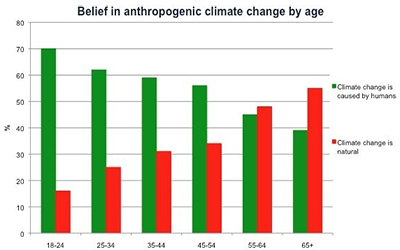
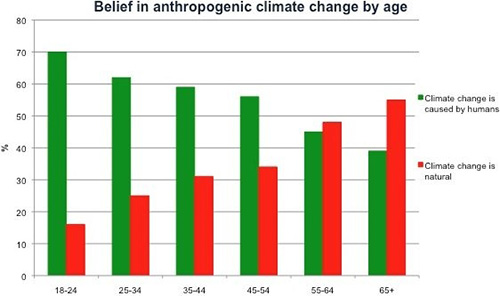
Best Understood: Younger people better get-it that anthropogenic global warming is not just another environmental issue, and very few of them buy into the asinine contention that because the climate has changed in the past, but on geological timescales, the concentration of potent heat-trapping atmospheric gases can be doubled within a few human generations without catastrophically overwhelming the ability of built and natural systems, and species, to adapt. chart Crikey data Essential Media Communications
Cohort that best understands the enormity of anthropogenic global warming is that least represented in Parliament.
It is also the age-group that is least enrolled, and votes least. But given the great gulf between the awful reality of global warming, and the blasé attitude of the political elite and the determinedly business-as-usual mainstream media, it is a minor miracle that even fewer younger New Zealanders vote, than the fewer-than-half who do.
The singular need, for younger people to become massively more engaged in the electoral process, is for there to be a political party with predominantly young candidates. But not just candidates that look young to the age-group that is best represented in Parliament, the 40–59-year-olds, they must look young to the age group most critical for recruitment as lifelong voters: college students, which means candidates need to be twentysomethings. While it is possible that an existing party, such as the Mana or the Green Party, could reinvent itself as one fielding predominantly twentysomething candidates, what is simultaneously needed is for effective climate action to be the overarching mission of such a party, rather than an add-on.
The principal reason people give for failing to vote are other commitments, including work. This was particularly prevalent among younger people polled after the 2008 election, when 40% gave that reason—young people are more likely to live in the moment than those older, with their more-ordered lives. This preoccupation with more personally proximate priorities is, of course, atop the already high number of younger non-voters—42% of ages 18–24, compared to just 5% of those 65 and older, in the 2011 election.
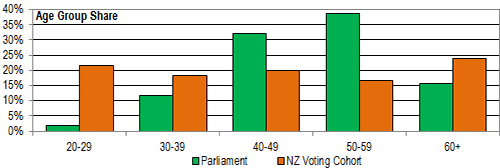
Least Represented: One day, the comfortable assumption that young people can be adequately and fairly represented by those much older will seem as quaint as the pre-1893 notion that women could be perfectly adequately represented by men. While it should, long since, have been fought for as an issue of electoral fairness, it is now an existential issue, given young people’s far better grasp of anthropogenic global warming. chart New Zealand Parliamentary Library
The elegant suggestion of one 23-year-old Mahurangi grandson who fully intended to vote on 20 September but failed to, is to facilitate voting, online or by app, at any time. In the 2014 general election, an unprecedented 0.72 million, or 23% of registered voters, advance-voted, but again, it is highly probable that these were mostly older, more-organised voters. Aside from the crippling cost of the current booth-based electoral system, there is no reason why advanced voting should be restricted to 15 polling days ahead of Election Day. Or, for that matter, any reason, up until the booths close at 7 pm on the actual election day, that an advance vote shouldn’t be amended.
Such an advance-voting system, of course, would also need to be an online one. With all due credit to Estonia, where a quarter are already voting online, this is another electoral area in which Aotearoa should lead the world. Of course, whenever online voting is suggested, great concern is professed about the potential for elections to be nefariously manipulated. But the reason so much cold water is poured upon online voting is not the professed concern for electoral integrity, but a concern that more people will vote—the same reason behind the feigned Republican concern for voter fraud, which is a barely disguised, ongoing campaign by the party to make it needlessly difficult for America’s poor and black populations to register to vote.
The United States is not alone, and it is profoundly unconvincing that elites of societies so spectacularly preoccupied material wealth, but so careless of basic democratic rights, should suddenly profess such overweening concern for electoral fidelity. Besides, not only has online banking proven to be reliable, and popular, it is now being comprehensively eclipsed by smartphone banking.
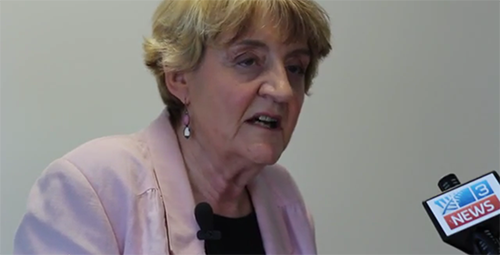
Science Fundamental: Dr Jan Wright, introducing her report Changing Climate and Rising Seas – Understanding the Science ‘…I’m a believer, that in understanding environmental matters, a knowledge of the basic relevant science is fundamental.’ Sadly, a concept foreign to most of her generation, and to most of the members of the parliament she serves so astutely and courageously. image Parliamentary Commissioner for the Environment
Anthropogenic global warming will soon test contemporary civilisation like never before; even the United States military is concerned about what it terms a threat multiplier:
Rising global temperatures, changing precipitation patterns, climbing sea levels, and more extreme weather events will intensify the challenges of global instability, hunger, poverty, and conflict. They will likely lead to food and water shortages, pandemic disease, disputes over refugees and resources, and destruction by natural disasters in regions across the globe.
The United States’ electoral system is so comprehensively compromised, from shamelessly gerrymandered Electoral College districts to its two-party system bought-and-paid-for by corporate self-interest, that it is unlikely to be reformed and made resilient in a timeframe useful to effective, democratically determined climate action. In fact the denialist drum beaten for decades is that global warming is a hoax devised to embolden big, even global, government. This has helped ensure that the Keynesian strategies that were once universally saluted for helping put economies and the people back on their feet, are demonised as ‘command and control’. What is left, of course, is command and control, but by the corporates for the corporates.
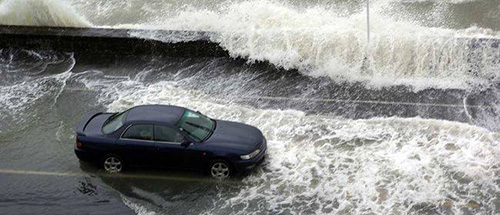
Threat, Promise or Opportunity: Before blocking every climate action initiative, those obsessed with economic growth might consider the potentially crippling cost of climate inaction, but also the opportunity to rebuild in a more sustainable manner, at elevations that will provide security for centuries, rather than a few decades. Tāmaki Drive, February 2014. image Science Media Centre
Diminutive Aotearoa is a vastly different kettle of fish. With its proud history of social innovation, notably electoral, there is no country better-positioned to demonstrate how democratic governance can be optimised for effective climate action. Christchurch is a prime example of the textbook neoliberal response to natural disasters to suspend democracy and divvy up the opportunities amongst the deep-pockets of the mainstream political parties’ sugar daddies. Likewise, its response to terrorism is further de-democratisation. The imperative for re-democratisation, of course, is not just confined to adaptation to warming, but to decelerate its awful onset. Seventeen years of climate inaction, counting from the Kyoto Protocol, or 26 years from Dr James Hansen’s Congress testimony, or 42 years since the Club of Rome warned of the Limits of Growth, and fossil fuel use continues inexorably to increase. Leaving climate action to the invisible hand of the market, with or with emissions-trading scheming, has proven to be as bereft of benefit as any economics student with a half-engaged brain could have predicted. Aotearoa, almost overnight, could slash its transport emissions by maximising the use of fibre-optic cable and prioritising road use for buses and service vehicles. Rail was once the gold standard for sustainable urban transport, but Auckland, for example, has left its embrace of rail sixty years too late. For many workers, the need to huddle under the same roof, or on the same floor or floors, has long-since dematerialised. Non-enterprise-specific workplaces, within walking or cycling distance of the worker, with adjoining café to facilitate worker interaction and appropriate breaks, would also result in increased productivity, and with much lower overheads, than the transport-intensive high-rise business-district model slavishly followed. Health outcomes would also improve.
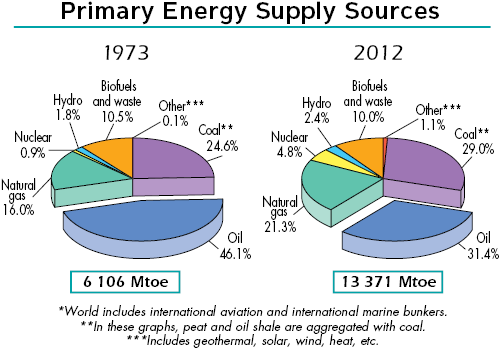
Limits of Growth: Since the 1972 Limits of Growth, and the first oil shock the following year, energy use has more than doubled, while the percentage of renewable energy, including geothermal, has reached a mere 1.1% share of it. If climate-disrupting use of fossil fuel is to be sharply curtailed, without condemning the three billion people already living in energy poverty, including the 1.3 billion totally deprived of any electricity, developed countries need to strongly support China, India and others in rapidly building up their nuclear-power share—the limits of growth for a globally significant energy contribution from photovoltaic sources need to be honestly and promptly acknowledged. chart Key World Energy Statistics 2014
But while the re-purposing of the roads offers an immediate opportunity to radically reduce fossil fuel use, a significant and critical portion of that infrastructure has been built, and continues to be rebuilt, at sea level. Makaurau’s iconic Tāmaki Drive presents a particularly high-profile conundrum, but raising its 8.2 kilometres is dwarfed, for example, by challenge of replacing the greater part of the 54-kilometre Thames–Coromandel Road that sits, increasingly, within storm-surge reach. Meanwhile, the asinine obsession with projecting the amount by which sea level might rise by the year 2100 totally misses the point that sea-level rise won’t stop at 2100, but, by any plausible projection, will only be continuing to accelerate. The only utility of a 2100 projection is in helping determine how many million or billion dollars it might take to buy 85 years of wriggle room for any particular section of road or motorway. If local and central government were diligently exploring these scenarios, New Zealanders, by now, would appreciate that global warming is not something that a few, or even a few million, photovoltaic panels were going to solve.
With global-warming-augmented storm surges beginning to strike in earnest, local and central governance needs to respond a great deal faster than it is currently capable of. But without a commensurate improvement in democratic processes, this will translate into a drastic erosion of voter opportunity to participate in decision-making. Rather than a three-year electoral cycle, with its three-yearly circus of electioneering, a system of annual, or even continuous, re-mandating, which an online advance-voting system would facilitate, is urgently needed. This would be a far healthier model than the current cynically practiced focus-group- and opinion-poll-led, they-will-have-forgotten-most-of-it-by-Election-Day, politics.
A radical climate action party, in addition to being fronted by twentysomething candidates, will need to campaign for a raft of electoral reform measures aimed at rapidly recruiting younger voters. Dropping the voting age to 16½, the age New Zealanders can hold a restricted-driver’s license, would mean that rather than some young people being nearly 21 before they can vote for the first time, all New Zealanders would be entitled to vote well before they turned 20, greatly increasing the likelihood they would become lifetime voters.
Although implementing anytime-voting, and lifetime-enrolment, would be a bigger challenge, rather than wait for Parliament, the Rad Party, or whatever it was termed, could hold parallel elections via its app, for all those of college age or over—the earlier young people have their first voting experience, again, the greater the odds of them becoming habitualised.
Just how nasty global warming becomes and how quickly, and how humanely and effectively or otherwise governments respond demands that the cohort that best understands the challenge be fairly represented in Parliament.
